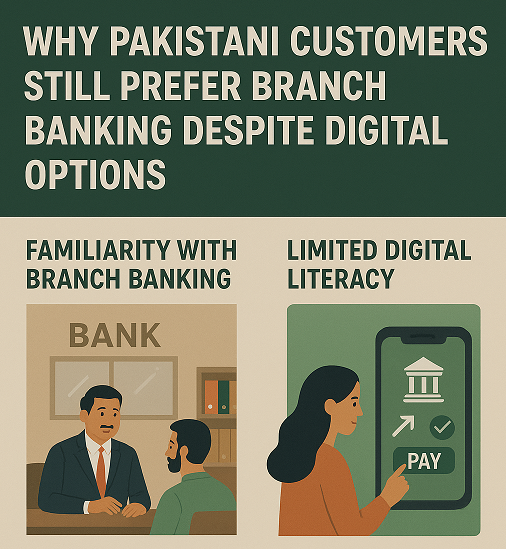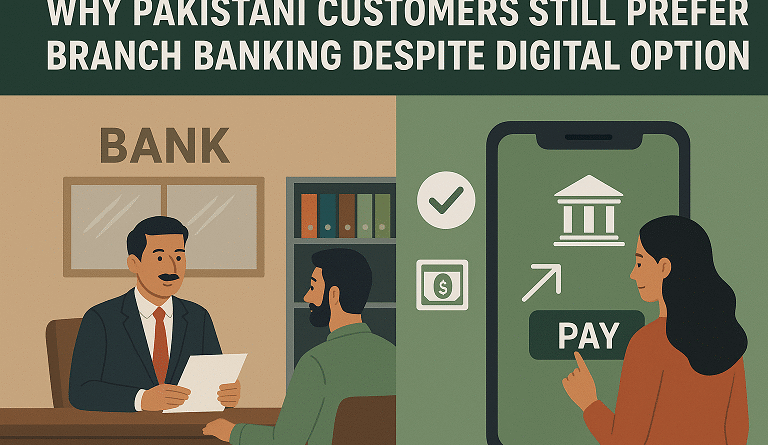Why Pakistani Customers Still Prefer Branch Banking Despite Digital Options
1. Large-Value Transactions and Trust Concerns

Despite robust growth in digital banking volume, paper-based instruments remain the dominant mode for high-value transactions in Pakistan which lead to Customer Branch Banking Preference. In FY23, while e-banking accounted for 80% of transaction volume, paper-based payments still represented a majority of transaction value, with average cash deposit and withdrawal sizes reaching Rs 295,925 and Rs 217,549, respectively. Similarly, in FY24, digital payments reached 84% by volume but only 17% by value, underscoring that customers still rely on in-person banking for significant financial dealings.
2. Value Disparity: Branch Customers vs. Digital Users
Branch customers generate significantly higher deposit values than digital or branchless users. As of June 2024, branchless banking accounted for 120 million accounts but held just Rs 138.9 billion in deposits, whereas traditional bank accounts (much fewer in number) held over Rs 14.2 trillion, a disparity of more than a hundredfold. Similarly, microfinance branch users held average deposits of Rs 45,327 vs. Rs 1,150 for digital users.
3. Security, Trust, and Behavioral Barriers
Digital banking adoption is hindered by several behavioral and perceptual factors lead to Customer Branch Banking Preferences:
- Privacy and surveillance concerns—termed the “big brother effect”—reduce users’ comfort with smart banking.
- Studies point to low internet penetration, security fears, weak legal protections, and cultural resistance as major obstacles to IT-based banking in Pakistan.
- A targeted qualitative study noted that while functionality (usability, performance, ease) drives interest in smart banking services, financial literacy and trust remain critical.
4. Infrastructure Limitations and Digital Divide
Though infrastructure is evolving, branch presence and tangible accessibility still matter:
- Pakistan’s digital payments systems are improving—internet banking users grew to nearly 12 million, mobile banking to about 18.7 million, and there were 125,593 POS machines by FY24.
- Yet, as of June 2024, fewer than 20 million bank accounts were active digitally, despite there being over 211 million registered accounts, indicating that reach is not the issue—relevance and trust are.
5. Hybrid Banking: Balancing Digital Convenience with Human Touch
The hybrid banking model, combining digital platforms with branch accessibility, is gaining traction. For example, Mashreq Bank’s hybrid model in Pakistan is designed to bridge trust gaps and serve customers—especially remittance recipients—through both digital channels and physical support.
6. Cultural Preferences and Value of Human Interaction
Although formal studies are limited, anecdotal evidence from customers underscores frustrations with digital systems and a deep-rooted preference for in-person service:
“Opening an account… process was extremely long… they made me feel like they were doing me some kind of favour…”
“Online banking suck ass, that’s why…”
These voices reflect a broader sentiment that physical presence and human interaction provide reassurance and control that digital avenues often lack.
Summary Table
| Factor | Why It Reinforces Preference for Branch Banking |
|---|---|
| High-value transactions | Customers trust branches for large sums, despite digital convenience |
| Deposit value gap | Branch customers deposit significantly more, boosting bank revenue |
| Trust & behavioral barriers | Concerns about privacy, literacy, and security hinder digital uptake |
| Infrastructure & relevance | Digital access exists, but users find more relevance in branch services |
| Hybrid models | Combining digital and physical touchpoints helps bridge trust gaps |
| Cultural preference | Many users still prefer face-to-face interaction over digital systems |
Conclusion
While Pakistan’s digital banking landscape is growing swiftly, branches remain indispensable for many because:
- Large, high-value transactions still rely on face-to-face trust.
- Branch banking yields greater financial value per customer.
- Concerns—from privacy to digital literacy—hamper digital adoption.
- Hybrid models are a promising path forward but are still nascent.
- Cultural habits and customer confidence continue to anchor preferences in branch banking.
For future digital adoption to thrive, banks must focus on building trust, usability, and meaningful value, integrating hybrid frameworks, and improving financial literacy and digital relevance, particularly among rural and underserved populations for change in Customer Branch Banking Preference.

